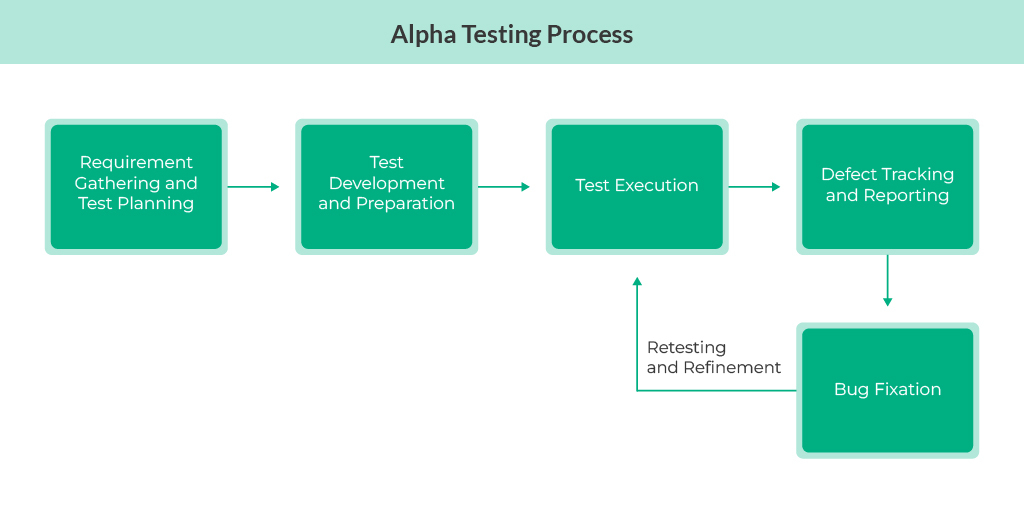Software defects and issues can lead to significant challenges, including financial losses and damage to your company’s reputation. Businesses allocate significant resources to implement thorough testing protocols, aiming to ensure that their products meet the performance benchmarks.
Before the public release, software undergoes a meticulous testing cycle to ensure it is free from bugs and functions as intended. One crucial aspect of this testing cycle is alpha testing.
Alpha testing is designed to detect any defects in the software and verify that it aligns with the specifications set by the development team. As an essential part of the software development process, alpha testing helps with the early detection of possible issues, saving both time and money in the long run.
This blog post covers the objectives of alpha testing, including its process, types, benefits and various other aspects. Keep reading to learn more.
What is alpha testing?
Alpha testing is an internal testing process conducted by the internal team to confirm the product meets the business requirements and functions as expected. It is a type of User Acceptance Testing (UAT) and is typically conducted in a controlled environment, such as a test lab. This allows effective control over the testing environment to maintain the integrity of the results.
The primary objective of alpha testing is to refine the software by fixing issues ranging from small glitches to major system failures. During alpha testing, both black box and white box techniques are used to assess the software’s functionality, usability, and performance.
Black box testing involves testing the software without any knowledge of the system’s internal workings. It is purely based on the input and output, without any concern for the internal code. On the other hand, white box testing, also known as clear box or transparent testing, is where the internal structure is known to the tester. It focuses on checking how well the system operates and flows, i.e., testing the internal logic of the system. Check out the difference between black box and white box testing here.
Types of Pre-release Testing
Pre-release testing is a series of tests done to ensure the software is ready for end-users and meets the specified requirements. It aims to detect and remove defects, errors or bugs in products before they are shipped. With the increasing complexity of software products, pre-release testing has become vital to make sure that new features and updates are included with the confidence that they will not have any negative impact on the end-user experience.
There are three primary types of pre-release testing:
Alpha Testing: It is a form of external user acceptance testing carried out by a team of internal employees of the organization and QA testers. They mimic how potential users interact with the software to confirm the business requirements are met and to identify any bugs or issues before releasing it to a wider audience. During the alpha test, testers use black box testing to verify that the software performs the specified functions as expected. Then, the alpha testers employ the white box testing method to ensure that the software’s internal logic and code are working correctly.
Beta Testing: Beta testing is the second stage of pre-release testing, conducted by a selected group of users in a real environment. Unlike alpha testing, which is conducted in a controlled environment, this process is conducted in the actual environment where the software will be used. The main objective of a beta test is to identify any issues or bugs that may arise from real-world usage and to gather feedback from the target audience on the software’s functionality, usability, and overall user experience.
Gamma Testing: This is the last stage of the testing process, performed when the product is ready for release with specific requirements. It focuses on security testing, performance checks, and usability of the product. The testing phase imposes limitations on the extent of product modifications, apart from those software issues that must be addressed. This stage serves as a vital step in securing a successful product launch. The table below shows the difference between alpha, beta and gamma testing in detail.
| Basis | Alpha Testing | Beta Testing | Gamma Testing |
| Purpose | To validate software in a real perspective and ensure readiness for beta testing. | To ensure users’ readiness for release and get end users’ feedback. | To check the software program’s readiness for full release. |
| When to Use | It is conducted during the early stages of development | It is used when the product is feature-complete and needs real-world validation. | It is employed after beta testing to ensure readiness for a wider release. |
| Conducted By | It is performed by internal testing teams. | It involves a limited group of external users known as beta testers. | It involves a limited number of end users. |
| Objective | To simulate end-users actions to verify software behavior under real-life conditions. | To gather real-world feedback and identify potential issues before a wider release. | To test the security and functionality of the software. |
What is the Goal of Alpha Testing?
Alpha testing is a vital checkpoint to determine the software’s readiness for public release. Here are the different reasons why alpha testing is performed:
- Identify Bugs: Alpha testing helps uncover and rectify bugs that might have slipped through previous testing phases.
- Quality Validation: This method is useful to validate the quality, functionality, and effectiveness of the application before it reaches the end-users.
- Compatibility Analysis: Alpha testing plays an important role in determining software compatibility with different hardware configurations and operating systems.
- Stability Assurance: Load testing is performed under alpha testing to understand the ability of the software to handle heavy usage.
- Actionable Feedback: Feedback from alpha testing is useful to address bugs, improve performance, and streamline features before the final release.
Who is Responsible for Alpha Testing?
Alpha testing is typically headed by the Quality Assurance (QA) team and the software development team. They test the software, pinpoint bugs, and report usability issues. These findings are accurately documented in a bug-tracking system or communicated directly to the development team.
The development team, on the other hand, takes the baton from QA testers during alpha testing. They check the issues uncovered by the testers, developing and implementing effective solutions to ensure that the software operates seamlessly.
Project managers oversee the entire alpha testing process. Their role is to ensure that the team adheres to deadlines and delivers a refined product. They coordinate between the QA testers and the development team, ensuring a smooth flow of information and timely resolution of issues.
The culmination of alpha testing is signified by the resolution of all significant issues. This stage, often referred to as ‘feature lock’, is where the product’s functionality is frozen, and no new features are added.
Types of Alpha Testing
Alpha testing can be broadly categorized into two types: White Box Alpha Testing and Black Box Alpha Testing.
White Box Alpha Testing
Also known as structural testing, it is a method where the internal workings of the software are known to the tester. The tester can check the source code to create test cases that confirm the software’s functionality at the code level.
The tester checks whether each function, loop and logical branch in the code is working correctly. This ensures that all paths through the program are tested and that all possible inputs and outputs have been considered. This rigorous testing method helps to ensure that the software is robust, reliable, and secure.
Black Box Alpha Testing
On the other hand, this is a technique where the tester is not concerned with the software’s internal workings. The focus here is on the input and output of the software. There is no access to the source code for the tester who checks the software based on its functionality and user interface. This type of testing is like checking if the lights turn on when you flip the switch without worrying about the actual wiring behind the walls.
Benefits of Alpha Testing
Here are the benefits of alpha testing that contribute to the overall success of software:
Identify and Fix Critical Issues Before Wider Release
Alpha testing allows for the detection of bugs and issues that may not have been discovered during the development process. As per a study published in the Future of Software Quality Assurance, this early identification offers a chance to address these problems before they reach end-users. By setting up warnings, reviewing logs regularly, and using robust monitoring and logging solutions, teams can reduce the likelihood of problems, ensuring a smoother user experience.
Improve Product Quality and User Experience
Alpha testing ensures that the software aligns with the target audience’s needs, ultimately boosting user satisfaction. It involves collecting feedback from internal teams, which provides valuable insights into any issues with the software. This process helps maintain high-quality standards by identifying and rectifying issues early on. Adherence to User-Centered Design principles during alpha testing ensures the product is intuitive and user-friendly. The practice of continuous experimentation and data-driven strategies during this phase contributes to the delivery of a superior product experience.
Reduce the Risk of Post-Release Problems
Alpha testing helps with the early detection and resolution of issues during the development phase. This plays an important role in reducing the need for extensive testing and bug rectification in later stages. A study by IBM revealed that defects found post-production or after release can cost 15 times more to fix compared to errors resolved early in development. A robust alpha testing process mitigates the risk of problems arising after the software has been released. It ensures that the software works as per plan and fulfils the stipulated requirements, thereby reducing the likelihood of problems in the production environment.
Process of Alpha Testing

Here are the steps for conducting alpha testing:
Planning and Preparation Stage
This is the first stage of alpha testing, where the development team defines the scope and objectives of the alpha testing phase. They identify the testers and their roles, develop a test plan outline, and identify the functionalities to be tested. A specific test case is built for each functionality.
In addition, they set up a testing environment that simulates real-world use as closely as possible. This environment is crucial for ensuring that the software behaves as expected when it is eventually released to the end-users.
Test Execution
Once the planning and preparation stage is complete, the next step is test execution. In this stage, the test cases are executed as per the plan. The testers document any bugs, crashes, or usability issues encountered. They also provide feedback on the overall user experience and suggest improvements.
The feedback gathered during the test execution phase provides insights into how the software performs under different conditions. This helps the development team make necessary adjustments before releasing the software.
Defect Tracking and Reporting
Testers help identify bugs and logging issues in a defect-tracking system. Each defect’s severity and priority are determined, and this information is communicated back to the development team for resolution. This process ensures that critical issues are addressed promptly, enhancing the software’s overall quality and reliability.
A test management platform can streamline the software testing process and boost the efficiency of the QA testing team. For instance, a comprehensive test management tool like QA Touch offers features that can aid in Alpha Testing by creating, managing requirements, and mapping the test cases. While executing the test cases, you can post the issues. So, you will have complete traceability from the requirements to test cases, test execution, and the Issues. You can also easily confirm if the specific business requirements are passed or failed with the Requirements Traceability Report.

Iteration and Refinement
Once the defects are reported, the development team works to fix them based on priority. After the issues are resolved, the affected functionalities are re-tested to ensure the issues are actually resolved. This cycle of testing, bug fixing, and re-testing may continue iteratively until a certain level of quality and stability is achieved. This process of evaluation, feedback, and refinement helps create reliable software.
Entry and Exit Criteria for Alpha Testing
Entry and exit criteria during alpha testing provide a clear roadmap for when to start and conclude the process.
Entry Criteria
- Documentation of business requirements or software specifications.
- Establishment of test cases for each requirement.
- Absence of urgent bugs.
- Test management tool for uploading test cases and logging issues.
- Configuration of the testing environment.
- Availability of a QA build for execution.
- Testing team equipped with an in-depth understanding of the software.
Exit Criteria
- Successful execution and passing of all planned test cases.
- Resolution of all critical issues.
- No further features are to be incorporated.
- Preparation of a test summary report for delivery.
Best Practices and Tips to Manage Alpha Testing
Here are some best practices and tips to manage alpha testing effectively:
- Comprehensive Issue Logging: It is essential to log all issues discovered during alpha testing, even if some are left unresolved for the time being. This allows the development team to revisit these items when time permits.
- Pre-Testing Review: Before starting alpha testing, testers should review the functional specs and test cases. This provides a context for their work and establishes a common understanding.
- Retesting by Issue Logger: The person who initially found a bug should be the one to confirm its resolution. This ensures that the issue has indeed been fixed.
- Consensus Before Transition: Before moving from alpha to beta testing, there should be a consensus among all involved that the product is ready. This provides an opportunity for anyone to raise concerns before the decision is finalized.
- Inclusion of Non-Technical Employees: Including a diverse group of users in alpha testing can provide a more comprehensive review of the product. Non-technical users may uncover issues that tech-savvy people might overlook.
Common Issues and Challenges in Alpha Testing
Here are some common issues that teams often encounter during this phase:
- Limited Scope: Alpha testing is conducted in a controlled environment, which may not fully represent the real-world scenarios that the software will encounter. This limitation can lead to overlooking certain bugs that might only surface under specific conditions.
- Time Constraints: Alpha testing can be time-consuming, especially if the software is complex or has many features. The process of identifying, documenting, and resolving issues can extend timelines.
- Resource Allocation: Allocating resources for alpha testing can be challenging, especially for smaller teams or organizations with limited resources.
- Bug Prioritization: Determining which bugs to fix first can be difficult, especially if many bugs were identified during alpha testing.
- Communication: Effective communication between the testers and the development team is crucial for the success of alpha testing.
When Should Automation be Used in Alpha Testing?
Automation can be a valuable tool in alpha testing under certain scenarios:
- Repetitive Tasks: If the alpha testing involves repetitive tasks, automation can be useful for saving time and lowering the risk of human error.
- Large Test Suites: If the software has a large number of test cases, automation can help execute them more efficiently.
- Regression Testing: Automation proves especially beneficial in regression testing scenarios, where the same set of tests have to be conducted several times.
- Load Testing: If the software needs to be tested under heavy loads or stress conditions, automation can effectively simulate these conditions than manual testing.
Conclusion
By identifying and fixing bugs’ usability issues and gathering user feedback early in the development process, alpha testing helps you save time and money. It is also useful in validating the software product’s idea, features, and value proposition with real users, increasing the chances of creating a successful product.
Following alpha testing, the next stage is beta testing. In this stage, the product is released to a wider target audience for further validation and feedback.
QA Touch can be a valuable tool in managing Alpha testing. It offers features like screen and audio recording for issue reporting, comprehensive issue tracking capabilities, and a user-friendly interface. These features, when combined with the ability to integrate with other tools, make QA Touch an invaluable tool for alpha testing.
If you are interested in learning more about how QA Touch can streamline your alpha testing process, Start your 14-day free trial.









